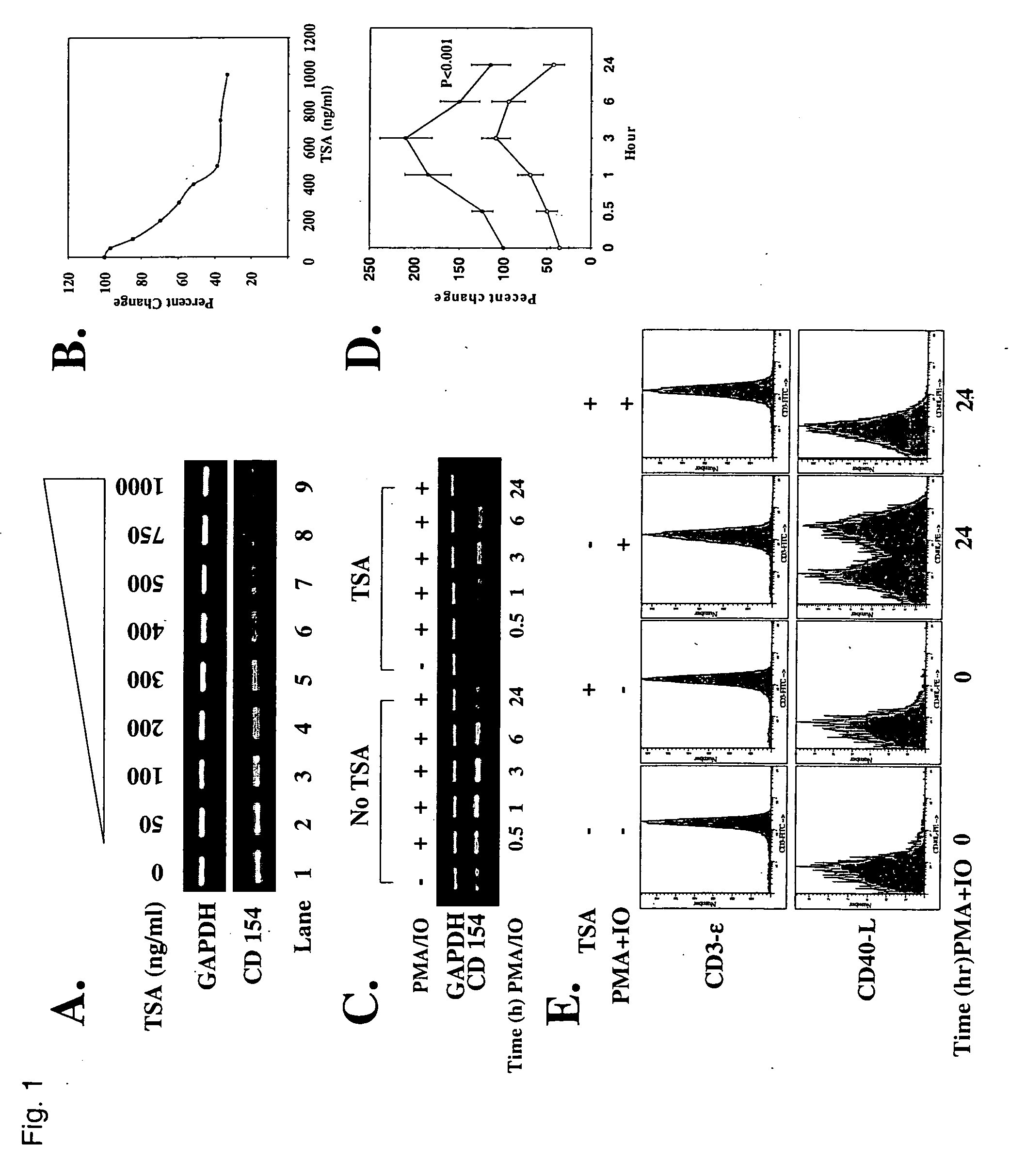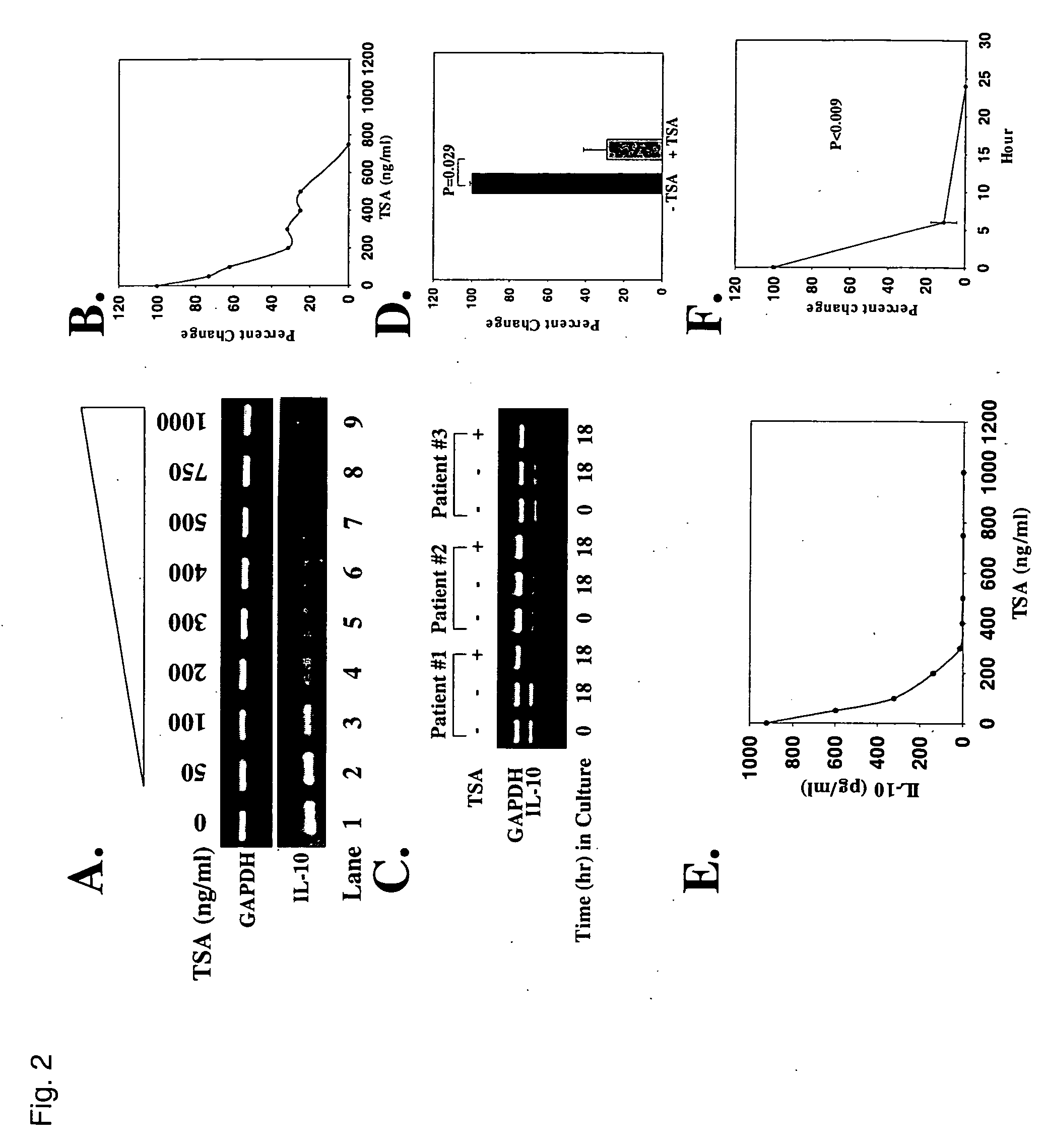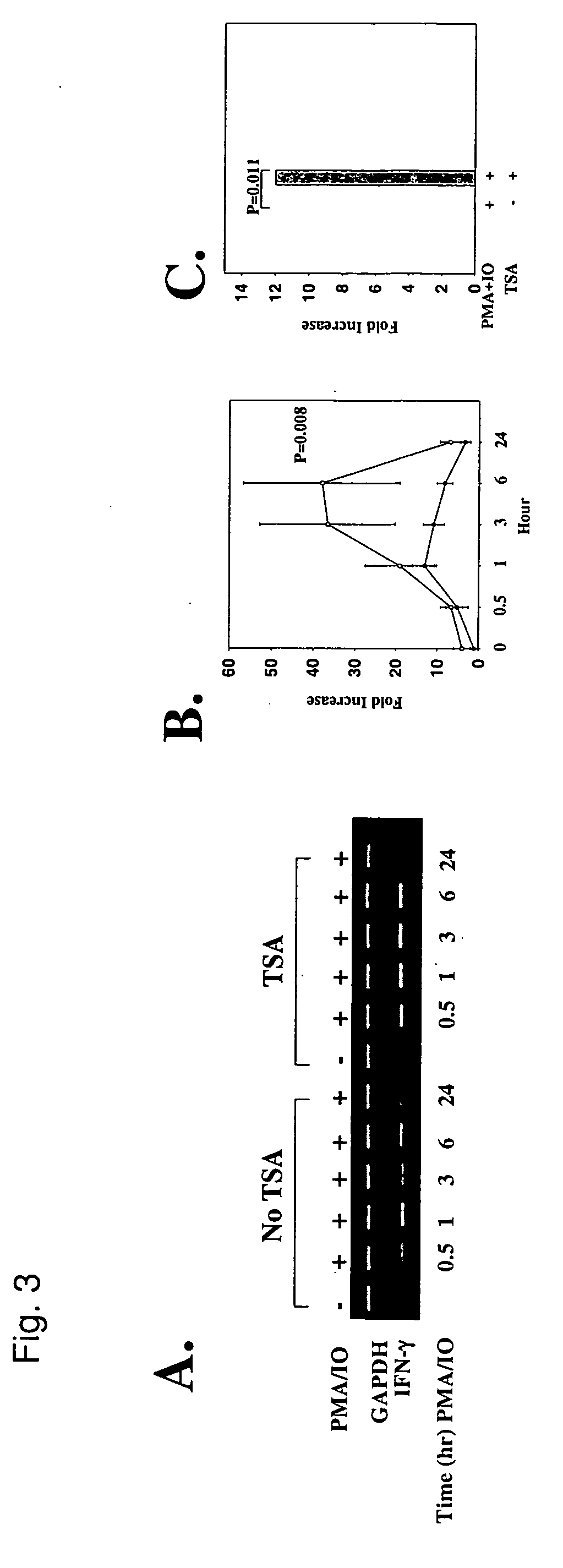Method of treating autoimmune diseases
a technology for autoimmune diseases and t cells, applied in the field of autoimmune diseases, can solve the problems of t cell dysfunctions predisposing to recurrent, life-threatening infections, and imbalances between exaggerated helper function and deficient cytotoxi
- Summary
- Abstract
- Description
- Claims
- Application Information
AI Technical Summary
Problems solved by technology
Method used
Image
Examples
example 1
Down-Regulation of CD154 Transcript and Protein Levels by TSA
[0067] Because SLE T cells are often activated (D. T. Y. Yu et al., J. Exp. Med. 151, 91 (1980).), the up-regulation of CD154 and IL-10 and down-regulation of IFN-γ may reflect skewed gene expression due to enhanced recruitment of HDACs to the promoters of these genes. The resulting dysequilibrium of acetylation might be expected to alter the chromatin structure of the promoters (R. D. Kornberg and Y. Lorch, Curr. Opin. Gen. Dev. 9, 148 (1999)), thereby activating previously silenced genes while repressing expressed genes. To determine if TSA can down-regulate CD154 transcript expression, T cells from eight SLE subjects were treated with increasing concentrations of TSA over 18 hr.
[0068] T cells were cultured in the absence or presence of increasing concentrations of TSA for 18 hr in 5% CO2 at 37° C. RNA was isolated, cDNAs were prepared, and RT-PCR was performed as previously detailed (D. Laxminarayana, et al., J. Clin....
example 2
Down-Regulation of IL-10 Transcript and Protein Levels by TSA
[0072] T cells from SLE subjects produce markedly increased amounts of IL-10 resulting in high serum levels of the cytokine (B. S. Handwerger, et al., in Lupus: Molecular and Cellular Pathogenesis, G. M. Kammer and G. C. Tsokos, Eds. (Humana Press, Totowa, N.J., 1999) chap. 21; E. Hagiwara, et al., Arthritis Rheum. 39, 379 (1996)). To determine whether TSA could down-regulate IL-10, a dose-response analysis was performed. Like CD154, increasing concentrations of TSA progressively inhibited IL-10 transcript expression (FIGS. 2A and 2B). In fact, based on sensitive reverse transcriptase-polymerase chain reaction (RT-PCR) analyses, no detectable IL-10 mRNA was identified at TSA concentrations of 700-800 ng / ml. By comparison, increasing concentrations of TSA did not modify GAPDH transcript expression (FIGS. 2A and 2B). As shown in FIG. 2C, IL-10 transcripts were present in freshly isolated T cells (0 hr; lanes 1, 4, 7) and re...
example 3
UP-Regulation of IFN-γ Transcript and Protein Levels by TSA
[0073] Low production of IFN-γ by SLE T cells may reflect down-regulation of gene expression (B. S. Handwerger, et al., in Lupus: Molecular and Cellular Pathogenesis, G. M. Kammer and G. C. Tsokos, Eds. (Humana Press, Totowa, N.J., 1999) chap. 21; E. Hagiwara, et al., Arthritis Rheum. 39, 379 (1996)). To establish whether TSA can up-regulate IFN-γ expression, SLE T cells were treated for 18 hr in the absence or presence of TSA. During that time, TSA induced a three-fold increase in IFN-γ transcript compared to untreated cells (FIG. 3A, lanes 1 and 7, and FIG. 3B). When T cells were activated with PMA+IO in the absence of TSA, peak IFN-γ transcript expression increased 13-fold at 1 hr over basal levels relative to GAPDH transcript, but waned thereafter. By contrast, activation of T cells in the presence of TSA induced a peak 37-fold increase in IFN-γ mRNA at 6 hr over untreated cells relative to GAPDH (FIGS. 3A and 3B; P=0.0...
PUM
| Property | Measurement | Unit |
|---|---|---|
| concentrations | aaaaa | aaaaa |
| pH | aaaaa | aaaaa |
| concentrations | aaaaa | aaaaa |
Abstract
Description
Claims
Application Information
 Login to View More
Login to View More - R&D
- Intellectual Property
- Life Sciences
- Materials
- Tech Scout
- Unparalleled Data Quality
- Higher Quality Content
- 60% Fewer Hallucinations
Browse by: Latest US Patents, China's latest patents, Technical Efficacy Thesaurus, Application Domain, Technology Topic, Popular Technical Reports.
© 2025 PatSnap. All rights reserved.Legal|Privacy policy|Modern Slavery Act Transparency Statement|Sitemap|About US| Contact US: help@patsnap.com



